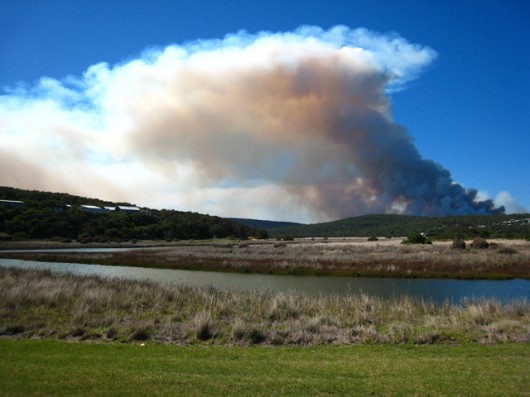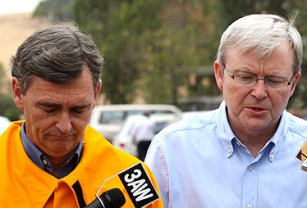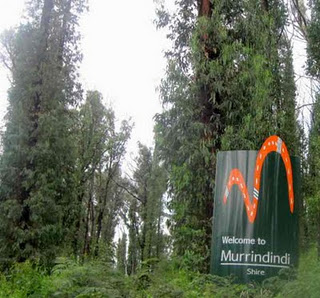Victorian Bushfires Commission – what value?
Thursday, November 10th, 2011 Ash Wednesday Bushfires in 1983 – approaching Anglesea on Victoria’s Great Ocean Road, Australia
Ash Wednesday Bushfires in 1983 – approaching Anglesea on Victoria’s Great Ocean Road, Australia
.
This article was initially published by Tigerquoll 20090622 on CanDoBetter.net in the aftermath of the devastating Victorian bushfires that climaxed on 7th February 2009, quickly branded by the media as ‘Black Saturday‘: Ultimate responsibility at the time – Victorian Premier Brumby and Australian Prime Minister Rudd (and tomorrow is Armistice Day when nearly a hundred years ago people questioned… ‘Ultimate Responsibility‘).
The Victorian Premier Brumby’s Royal Commission into the January-February 2009 bushfires is a mere incident review. If Victoria is to be protected from firestorms in future, it should undertake a root cause analysis, including the numerous past investigations into bushfires, with a view to achieving a cultural shift in rural fire fighting methods, resourcing and emergency management and into ecology management, housing approvals in bushfire prone areas, building design in bushfire prone areas, bush arson criminology and into serious resourcing of rural fire management.
Indeed, given the repeated history of bushfires across Australia and the repeated uncontrolled nature of many of these leading to extensive property damage, the loss of thousands of livestock, widespread ecological destruction, the human lives lost and injuries, and the massive costs incurred every year, the scope of the enquiry should be escalated to a national level.
But the Victorian Commission’s terms of reference focuses on the immediate causes and circumstances of the 2009 Victorian Bushfires. It focuses on the immediate management, response and recovery. This is a start, but the real start occurred in 1939 with the shock of Black Friday. It lead to the Stretton Enquiry, but many large and damaging firestorms have occurred since – so the Stretton Enquiry showed that lessons were either ignored or the application of those lessons were ineffective. The Esplin Inquiry of 2003 identified striking parallels between 1939 and 2002-3 bushfires. Now we have the 2009 Bushfires, but each investigation is disconnected from the previous one, almost as if to intentionally ignore history and any prior lessons learnt. Interstate and overseas, many major bushfires and their subsequent investigations have amassed research, insight and lessons. Why limit the investigation to one event?
Incident investigation will uncover causes and flaws and will likely make specific recommendations in the hope of preventing similar incidents. But root cause analysis goes beyond identifying the symptoms of a problem. But the Commission has not started with identifying the problem.
- Let’s premise that at the core is the problem of preventing ignitions becoming firestorms.
- What are the causes of uncontrolled ignitions in the bush.
- Where are they typically lit?
- How are ignitions detected by fire authorities?
- What is the time lapse between ignition and detection?
- What is the time lapse between detection and response and eventual suppression?
- Which causes and interventions would mitigate the risk of these ignitions developing into uncontrollable firestorms?
- Are the ignition detection tools adequate?
- Are the communications tools adequate?
- Do we have the right tools and trained personnel in the right places to effectively respond?
- Is the entire detection, response and suppression system sufficiently integrated to deal with multiple ignitions in extreme conditions across the State at the same time? How would this be achieved?
- What budget would be required to have such resources and technology in place to achieve this standard?
- Is the problem indeed too big for Victoria by itself to adequately deal with and so is the problem in fact a national one?
- How would a satisfactory solution be achieved without causing other problems like ecological damage and local wildlife extinctions?
.
Then implement the recommendations and scientifically monitor their effectiveness.
However, the Commission is looking at what caused the specific ignitions, what damage the specific bushfires caused and specific responses. It will conclude what specifically should have been done in these specific incidents. It will lead to a blame game that will solve nothing. Subsequent ignitions if not predicted, detected, responded to and suppressed to prevent firestorms, will likely have different circumstances in different locations. So how will the problem have been solved by this royal commission?
.
.
What about the affected people up in the Bush?
.
Horror, shock, helplessness, anger, loss – loved ones, family, next door neighbours, familiar faces gone. Then there’s financial loss, bank issues – sympathy first but then demands, threats and ambivalence. This is whole livelihoods. It is devastation. The initial trauma (community and personal), plus the ongoing trauma (community and personal).
Governments do the obligatory media spin, but as months pass they move on to other priorities. But the people don’t – whether they end up staying or going, the trauma stays.
This was absolutely catastrophic! Catastrophic! No-one can prepare or recover as easy as Government claims. What is ‘moving on’?
This is War Reparations league! A war hit here and ordinary people were simply living their ordinary lives in the bush. Another token bushfire enquiry without bushfire reform is repugnant, ignorant and callous. How will the Victorian Royal Commission prevent bushfire history repeating itself?
If our society could cope before, we may accept fate. But knowing the extreme risk in February 2009 and now, fate is no excuse. It is wrong for government to pursue bushfire management nonchalant business-as-usual in Victoria… in Australia.
.
.
Footnote
.
My uncle and aunt lost their family home down at Angelsea during the 1983 Ash Wednesday bushfires. They weren’t insured. Though they escaped with their lives, they lost everything else. Thereon they were never really quite the same. They became refugees in their home community.
 Anglesea Dreaming – a recollection of one’s youth and holidays
Anglesea Dreaming – a recollection of one’s youth and holidays
.











